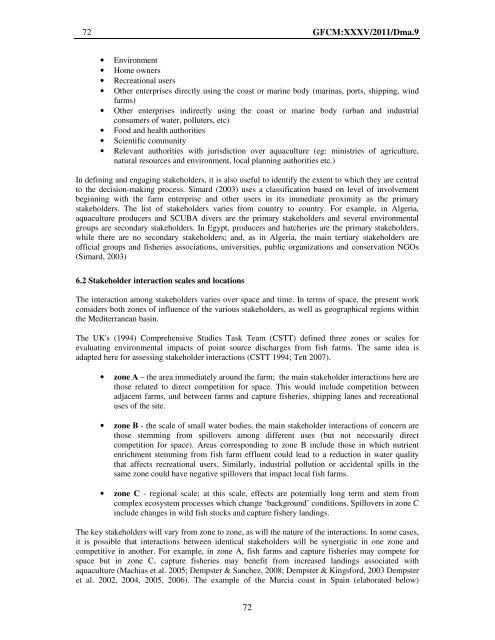Site selection and carrying capacity in Mediterranean ... - FAO Sipam
Site selection and carrying capacity in Mediterranean ... - FAO Sipam
Site selection and carrying capacity in Mediterranean ... - FAO Sipam
You also want an ePaper? Increase the reach of your titles
YUMPU automatically turns print PDFs into web optimized ePapers that Google loves.
72 GFCM:XXXV/2011/Dma.9<br />
• Environment<br />
• Home owners<br />
• Recreational users<br />
• Other enterprises directly us<strong>in</strong>g the coast or mar<strong>in</strong>e body (mar<strong>in</strong>as, ports, shipp<strong>in</strong>g, w<strong>in</strong>d<br />
farms)<br />
• Other enterprises <strong>in</strong>directly us<strong>in</strong>g the coast or mar<strong>in</strong>e body (urban <strong>and</strong> <strong>in</strong>dustrial<br />
consumers of water, polluters, etc)<br />
• Food <strong>and</strong> health authorities<br />
• Scientific community<br />
• Relevant authorities with jurisdiction over aquaculture (eg: m<strong>in</strong>istries of agriculture,<br />
natural resources <strong>and</strong> environment, local plann<strong>in</strong>g authorities etc.)<br />
In def<strong>in</strong><strong>in</strong>g <strong>and</strong> engag<strong>in</strong>g stakeholders, it is also useful to identify the extent to which they are central<br />
to the decision-mak<strong>in</strong>g process. Simard (2003) uses a classification based on level of <strong>in</strong>volvement<br />
beg<strong>in</strong>n<strong>in</strong>g with the farm enterprise <strong>and</strong> other users <strong>in</strong> its immediate proximity as the primary<br />
stakeholders. The list of stakeholders varies from country to country. For example, <strong>in</strong> Algeria,<br />
aquaculture producers <strong>and</strong> SCUBA divers are the primary stakeholders <strong>and</strong> several environmental<br />
groups are secondary stakeholders. In Egypt, producers <strong>and</strong> hatcheries are the primary stakeholders,<br />
while there are no secondary stakeholders; <strong>and</strong>, as <strong>in</strong> Algeria, the ma<strong>in</strong> tertiary stakeholders are<br />
official groups <strong>and</strong> fisheries associations, universities, public organizations <strong>and</strong> conservation NGOs<br />
(Simard, 2003)<br />
6.2 Stakeholder <strong>in</strong>teraction scales <strong>and</strong> locations<br />
The <strong>in</strong>teraction among stakeholders varies over space <strong>and</strong> time. In terms of space, the present work<br />
considers both zones of <strong>in</strong>fluence of the various stakeholders, as well as geographical regions with<strong>in</strong><br />
the <strong>Mediterranean</strong> bas<strong>in</strong>.<br />
The UK's (1994) Comprehensive Studies Task Team (CSTT) def<strong>in</strong>ed three zones or scales for<br />
evaluat<strong>in</strong>g environmental impacts of po<strong>in</strong>t source discharges from fish farms. The same idea is<br />
adapted here for assess<strong>in</strong>g stakeholder <strong>in</strong>teractions (CSTT 1994; Tett 2007).<br />
• zone A – the area immediately around the farm; the ma<strong>in</strong> stakeholder <strong>in</strong>teractions here are<br />
those related to direct competition for space. This would <strong>in</strong>clude competition between<br />
adjacent farms, <strong>and</strong> between farms <strong>and</strong> capture fisheries, shipp<strong>in</strong>g lanes <strong>and</strong> recreational<br />
uses of the site.<br />
• zone B - the scale of small water bodies, the ma<strong>in</strong> stakeholder <strong>in</strong>teractions of concern are<br />
those stemm<strong>in</strong>g from spillovers among different uses (but not necessarily direct<br />
competition for space). Areas correspond<strong>in</strong>g to zone B <strong>in</strong>clude those <strong>in</strong> which nutrient<br />
enrichment stemm<strong>in</strong>g from fish farm effluent could lead to a reduction <strong>in</strong> water quality<br />
that affects recreational users. Similarly, <strong>in</strong>dustrial pollution or accidental spills <strong>in</strong> the<br />
same zone could have negative spillovers that impact local fish farms.<br />
• zone C - regional scale; at this scale, effects are potentially long term <strong>and</strong> stem from<br />
complex ecosystem processes which change ‘background’ conditions. Spillovers <strong>in</strong> zone C<br />
<strong>in</strong>clude changes <strong>in</strong> wild fish stocks <strong>and</strong> capture fishery l<strong>and</strong><strong>in</strong>gs.<br />
The key stakeholders will vary from zone to zone, as will the nature of the <strong>in</strong>teractions. In some cases,<br />
it is possible that <strong>in</strong>teractions between identical stakeholders will be synergistic <strong>in</strong> one zone <strong>and</strong><br />
competitive <strong>in</strong> another. For example, <strong>in</strong> zone A, fish farms <strong>and</strong> capture fisheries may compete for<br />
space but <strong>in</strong> zone C, capture fisheries may benefit from <strong>in</strong>creased l<strong>and</strong><strong>in</strong>gs associated with<br />
aquaculture (Machias et al. 2005; Dempster & Sanchez, 2008; Dempster & K<strong>in</strong>gsford, 2003 Dempster<br />
et al. 2002, 2004, 2005, 2006). The example of the Murcia coast <strong>in</strong> Spa<strong>in</strong> (elaborated below)<br />
72
















